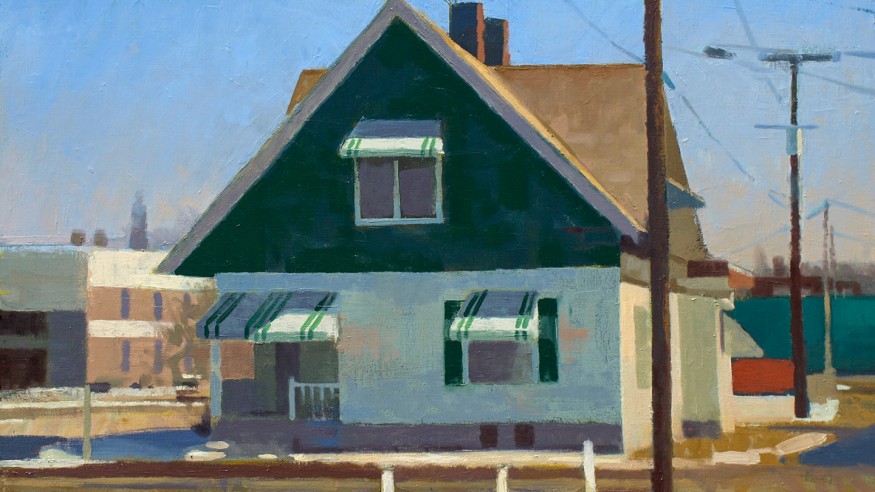
A Creative ‘Range of Vision’
Ohio Wesleyan’s Fine Arts Faculty to Exhibit Latest Works at Ross Art Museum
DELAWARE, Ohio – Ohio Wesleyan University’s fine arts faculty will showcase their artistic “Range of Vision” in a new exhibition featuring creations in clay, fiber, metal, painting and drawing, photography, printmaking, sculpture, and graphic design.
“Range of Vision” will be on display from Jan. 17 to March 30 at Ohio Wesleyan’s Richard M. Ross Art Museum, 60 S. Sandusky St., Delaware. A free, public artists’ reception with the faculty will be held from 4 p.m. to 6 p.m. Jan. 18.
Ohio Wesleyan faculty members showcasing artwork in the exhibition are:

Kristina Bogdanov, M.F.A., an associate professor who teaches ceramics, drawing, figure drawing, and 3-D design. “Memory is vital to shaping us into who we are,” said Bogdanov, who joined the university in 2007. “In a society that is obsessed to record reality on a daily basis, is it possible to question a real memory? Selectivity informs my work in a same way as the firing process transforms clay to structure into solid façade. The meaningful paradox of clay becoming stronger in fire is in direct relation to clay’s memory. My work is oxymoron, a retrieved virtual reality in fossilized form.”

Cynthia Cetlin, M.F.A., a professor who teaches metals, 3-D design, art education, art history, and, most recently, fiber arts. “After more than three decades of metalsmithing, the sensuous media of silk, wool and natural dyeing offer inspiring new possibilities,” said Cetlin, a member of the OWU faculty since 1987. “I am energized by the anticipation and the subsequent discovery as a new work emerges from a dye pot, or a new mold, or develops from a new pattern for a three-dimensional object. … The sheer joy of process and creation of objects keeps me going.”

Frank Hobbs, M.F.A., an associate professor who teaches painting, drawing, figure drawing, and 2-D design. Hobbs describes his paintings as “personal responses to particular situations that I’ve encountered in my wanderings in Ohio and in Italy.” “In working from observation,” said Hobbs, a member of the OWU faculty since 2007, “it’s the visual eccentricities of a given motif, their resistance to generalities that I find most exciting and engaging. The act of painting, for me, speaks of an underlying order and connectedness that it is my struggle and my delight to discover and to share.”

James Krehbiel, M.F.A., a professor who teaches in the 2-D media of printmaking, computer imaging, and drawing. Krehbiel’s work represents his research into sacred, prehistoric landscapes of the American West, including kivas. “Often kivas are isolated on remote ledges high in the canyons, but sometimes they are positioned in interesting ways in villages with alignments to unusual features in the landscape,” said Krehbiel, a member of the OWU faculty since 1986. His digital prints involve layering images taken over time to create narratives of the spaces he explores.

Jeff Nilan, M.F.A., an associate professor who teaches photography, computer imaging, bookmaking, and 2-D design. His pieces for the faculty exhibit include “Big Horn Canto,” taken out West. Nilan joined the OWU faculty in 2008 and of his teaching has said: “Teaching in a creative discipline is about drawing a student’s intuitive knowledge to the surface … My ultimate goal is to enable each student to locate their own voice and then to effectively communicate that voice using the visual language.”

Jonathan Quick, M.F.A., a part-time professor who teaches sculpture and 3-D design. Quick works in natural materials, primarily wood, metal, and stone. “There are three distinct directions in my studio production,” said Quick, who joined the university in 1988. “Iron foundry, in which art pieces are produced by the casting process; metal fabrication, in which cutting and welding are used to build sculpture; and woodworking. … In some of my work I seek form that invokes the natural forces implied by the process.”
David Bugay, B.F.A., a part-time instructor who teaches graphic design. “As a Graphic Designer, my style needs to be flexible to best fit the needs of the clients I work for. I get my inspiration from the world around me,” Bugay said. “Sometimes it is simply how the light is reflecting off of a window or how a certain building was designed. Other times [I] see the work of a certain artist and truly connect with their work.”
Ohio Wesleyan offers a Bachelor of Fine Arts degree with majors in studio art, art education, and art history. Learn more about the OWU Department of Fine Arts and its faculty at www.owu.edu/finearts.
During the academic year, the Ross Art Museum is open Tuesday, Wednesday, and Friday from 10 a.m. to 5 p.m.; Thursday from 10 a.m. to 9 p.m.; and Sunday from 1 p.m. to 5 p.m. The museum is closed for winter break until Jan. 17, when classes resume. It will close for spring break March 11 and reopen March 20. The museum is handicap-accessible and admission is always free. Call (740) 368-3606 or visit www.owu.edu/ross for more information.
Founded in 1842, Ohio Wesleyan University is one of the nation’s premier liberal arts universities. Located in Delaware, Ohio, the private university offers more than 90 undergraduate majors and competes in 23 NCAA Division III varsity sports. Through Ohio Wesleyan’s signature OWU Connection program, students integrate knowledge across disciplines, build a diverse and global perspective, and apply their knowledge in real-world settings. Ohio Wesleyan is featured in the book “Colleges That Change Lives” and included in the U.S. News & World Report and Princeton Review “best colleges” lists. Learn more at www.owu.edu.
